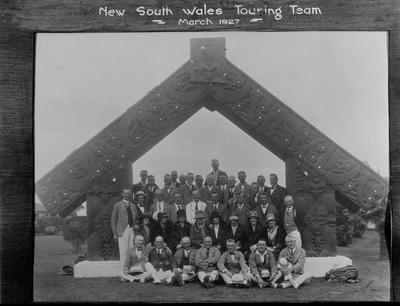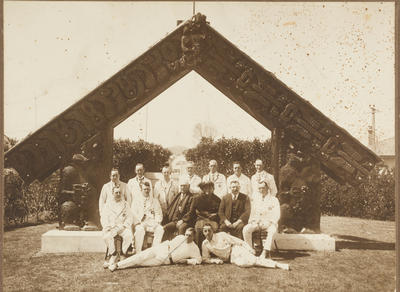Heni Materoa, Lady Carroll
Date of birth
Circa 1852
Date of death
01 Nov 1930
Biography
Heni Materoa, also known as Te Huinga, was born at Makauri, a few miles to the north-west of Turanga (Gisborne); her birth date could have been either 27 October 1852 or 29 October 1856. Her father was Mikaera Turangi of Ngai Tawhiri and Ngati Maru hapu of Rongowhakaata; he was the son of the Rongowhakaata leader Paratene Turangi. Her mother was Riperata Kahutia, a noted leader of Te Whanau-a-Iwi hapu of Te Aitanga-a-Mahaki. Heni Materoa's family was affiliated to tribes from Waiapu to Wairoa, and she traced her descent from all the paramount chiefs of the East Coast.
Most of Te Aitanga-a-Mahaki turned to Pai Marire in 1865. Riperata's people did not support the new movement; they moved to Turanga and established Piripono pa, on the banks of Waikanae Creek. There Heni Materoa spent her childhood. She had no formal schooling, but from the perspective of a secure and happy family she learned about the history and traditions of her people. She also saw the town of Gisborne spread over parts of their land after it was bought by the government in 1869. Over the next 15 years her mother, Riperata, was active in preserving her people's remaining lands and in reviving tribal life.
Perhaps about 1880 Heni Materoa met James Carroll (Timi Kara) of Ngati Kahungunu, who was a frequent visitor to the Gisborne area. Riperata Kahutia would not consent to their marriage, possibly because James was a Catholic and Heni an Anglican; the determined pair left Gisborne quietly by ship, and married in the Wellington registry office on 4 July 1881.
At the end of 1881 Heni Materoa Carroll (who became known to Maori as Heni Kara) and her husband returned to Gisborne, setting up house first at Matokitoki and then on Riperata's land at Waikanae. James Carroll may have returned to Wellington for his work as an interpreter. Much later, at the end of the First World War, they built a large house in Kahutia Street; it became a Gisborne landmark. Their homes were always full of people, for although they had no offspring they raised many children of relatives, in particular the children of Heni's brother Mikaera Pare Keiha.
Portraits of Heni Materoa show a serious face; she wears the moko of her rank, a kiwi feather cloak and a huia feather in her hair. She was described as having a gracious bearing and a willing smile and as being invariably well dressed. She chose not to go to Wellington when Carroll won the Eastern Maori parliamentary seat in 1887. She was, however, always ready to welcome his guests, amongst whom were former governor and premier Sir George Grey, and governor general Viscount Jellicoe. Honoured guests were customarily presented with fine cloaks or greenstone artefacts from the Carrolls' treasured collection.
Little detail is known of Heni Materoa Carroll's activities in the 1880s and 1890s. She was certainly one of the most influential Maori in the district, with sufficient mana to prevent the return of Te Kooti's body for burial at Poverty Bay. She accomplished much privately and informally. She was a generous benefactor to the community, gifting land and money to many causes, especially the welfare of women and children. She also supported several sports, notably women's hockey, golf and bowls; both the Heni Materoa Children's Home and the Kahutia Bowling Club were named in her honour. After James Carroll was appointed a KCMG in 1911 she was known to Gisborne Pakeha as 'The Lady'; to Maori she was known as Reiri Kara.
Heni Materoa's public career flourished during the First World War. She was associated with Apirana Ngata in various fund-raising endeavours for the Anglican church from 1914. She also supported him politically, and was chairperson of his electoral committee at Turanga that year. In March 1917 she officially opened the meeting room of his house at Waiomatatini, and from 1916 she joined him in canvassing for support for the Maori soldiers of the New Zealand Pioneer Battalion (later known as Te Hokowhitu a Tu).
Her major work was again in association with Ngata, raising funds to aid Maori soldiers abroad with gifts of food and money, and to invest for their future on their return to New Zealand. Heni Materoa Carroll was a member and chairperson of the Eastern Maori Patriotic Association founded by Ngata. When this organisation developed branches, she was one of the central steering committee and president of the Omahu branch. As a key person in the organisation she travelled the length and breadth of the east coast of the North Island, including Hawke's Bay and Wairarapa, attending and speaking at fund-raising hui. In April 1919 she was one of the speakers at the mass hui at Gisborne to welcome home Te Hokowhitu a Tu.
Always Heni Materoa was a 'Mother to the Maori people'. During the influenza epidemic of 1918 she persuaded Maori sufferers to enter temporary hospitals staffed by Pakeha doctors; she also persuaded Maori women to help with nursing. She was active in assisting the rehabilitation of wounded Maori soldiers. In 1918 she was made an OBE.
After James Carroll's death in 1926, Heni Materoa seemed to lose her interest in life; her health deteriorated and she died at her home on 1 November 1930. She was buried in the Carroll vault next to the Makaraka cemetery. The bishop of Aotearoa, F. A. Bennett, told a large memorial service at Holy Trinity Church, Gisborne: 'her whole soul was Maori. No-one in this country was more proud of her people…her word was mana.' Heni Materoa Carroll had achieved remarkable recognition for her advancement of Gisborne and of its people. Her quiet influence had transcended racial divisions and her mana was acknowledged by Maori and Pakeha alike.
Sheila Robinson. 'Carroll, Heni Materoa', Dictionary of New Zealand Biography, first published in 1996. Te Ara - the Encyclopedia of New Zealand, https://teara.govt.nz/en/biographies/3c5/carroll-heni-materoa (accessed 13 December 2018)
Most of Te Aitanga-a-Mahaki turned to Pai Marire in 1865. Riperata's people did not support the new movement; they moved to Turanga and established Piripono pa, on the banks of Waikanae Creek. There Heni Materoa spent her childhood. She had no formal schooling, but from the perspective of a secure and happy family she learned about the history and traditions of her people. She also saw the town of Gisborne spread over parts of their land after it was bought by the government in 1869. Over the next 15 years her mother, Riperata, was active in preserving her people's remaining lands and in reviving tribal life.
Perhaps about 1880 Heni Materoa met James Carroll (Timi Kara) of Ngati Kahungunu, who was a frequent visitor to the Gisborne area. Riperata Kahutia would not consent to their marriage, possibly because James was a Catholic and Heni an Anglican; the determined pair left Gisborne quietly by ship, and married in the Wellington registry office on 4 July 1881.
At the end of 1881 Heni Materoa Carroll (who became known to Maori as Heni Kara) and her husband returned to Gisborne, setting up house first at Matokitoki and then on Riperata's land at Waikanae. James Carroll may have returned to Wellington for his work as an interpreter. Much later, at the end of the First World War, they built a large house in Kahutia Street; it became a Gisborne landmark. Their homes were always full of people, for although they had no offspring they raised many children of relatives, in particular the children of Heni's brother Mikaera Pare Keiha.
Portraits of Heni Materoa show a serious face; she wears the moko of her rank, a kiwi feather cloak and a huia feather in her hair. She was described as having a gracious bearing and a willing smile and as being invariably well dressed. She chose not to go to Wellington when Carroll won the Eastern Maori parliamentary seat in 1887. She was, however, always ready to welcome his guests, amongst whom were former governor and premier Sir George Grey, and governor general Viscount Jellicoe. Honoured guests were customarily presented with fine cloaks or greenstone artefacts from the Carrolls' treasured collection.
Little detail is known of Heni Materoa Carroll's activities in the 1880s and 1890s. She was certainly one of the most influential Maori in the district, with sufficient mana to prevent the return of Te Kooti's body for burial at Poverty Bay. She accomplished much privately and informally. She was a generous benefactor to the community, gifting land and money to many causes, especially the welfare of women and children. She also supported several sports, notably women's hockey, golf and bowls; both the Heni Materoa Children's Home and the Kahutia Bowling Club were named in her honour. After James Carroll was appointed a KCMG in 1911 she was known to Gisborne Pakeha as 'The Lady'; to Maori she was known as Reiri Kara.
Heni Materoa's public career flourished during the First World War. She was associated with Apirana Ngata in various fund-raising endeavours for the Anglican church from 1914. She also supported him politically, and was chairperson of his electoral committee at Turanga that year. In March 1917 she officially opened the meeting room of his house at Waiomatatini, and from 1916 she joined him in canvassing for support for the Maori soldiers of the New Zealand Pioneer Battalion (later known as Te Hokowhitu a Tu).
Her major work was again in association with Ngata, raising funds to aid Maori soldiers abroad with gifts of food and money, and to invest for their future on their return to New Zealand. Heni Materoa Carroll was a member and chairperson of the Eastern Maori Patriotic Association founded by Ngata. When this organisation developed branches, she was one of the central steering committee and president of the Omahu branch. As a key person in the organisation she travelled the length and breadth of the east coast of the North Island, including Hawke's Bay and Wairarapa, attending and speaking at fund-raising hui. In April 1919 she was one of the speakers at the mass hui at Gisborne to welcome home Te Hokowhitu a Tu.
Always Heni Materoa was a 'Mother to the Maori people'. During the influenza epidemic of 1918 she persuaded Maori sufferers to enter temporary hospitals staffed by Pakeha doctors; she also persuaded Maori women to help with nursing. She was active in assisting the rehabilitation of wounded Maori soldiers. In 1918 she was made an OBE.
After James Carroll's death in 1926, Heni Materoa seemed to lose her interest in life; her health deteriorated and she died at her home on 1 November 1930. She was buried in the Carroll vault next to the Makaraka cemetery. The bishop of Aotearoa, F. A. Bennett, told a large memorial service at Holy Trinity Church, Gisborne: 'her whole soul was Maori. No-one in this country was more proud of her people…her word was mana.' Heni Materoa Carroll had achieved remarkable recognition for her advancement of Gisborne and of its people. Her quiet influence had transcended racial divisions and her mana was acknowledged by Maori and Pakeha alike.
Sheila Robinson. 'Carroll, Heni Materoa', Dictionary of New Zealand Biography, first published in 1996. Te Ara - the Encyclopedia of New Zealand, https://teara.govt.nz/en/biographies/3c5/carroll-heni-materoa (accessed 13 December 2018)





